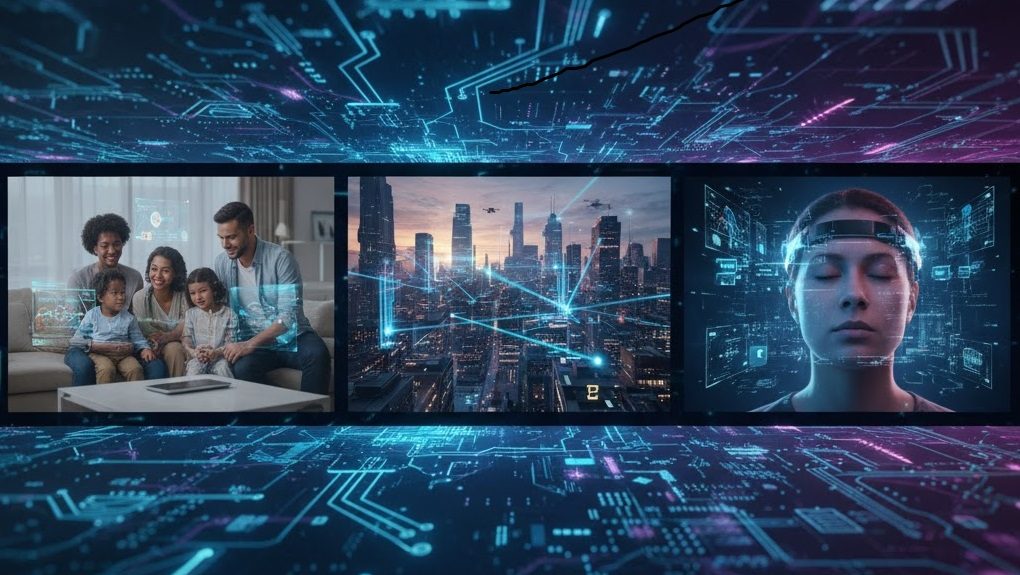The future of connectivity in America is on the brink of another revolution. Just as the world is getting comfortable with 5G networks, researchers and tech companies are already working on what comes next — 6G and beyond. These next-generation technologies promise ultra-fast speeds, near-zero latency, and an Internet experience that feels almost instantaneous.
As the backbone of the digital economy, connectivity impacts everything — from telemedicine and remote work to smart cities and autonomous vehicles. Understanding what comes after 5G gives us a glimpse into how America will lead the next wave of digital transformation.
In this guide, we’ll explore what technologies will succeed 5G, how U.S. industries and government are preparing for this transition, and what it means for everyday Americans.
Table of Contents
- What Comes After 5G?
- Understanding the Limitations of 5G
- The Evolution Toward 6G Networks
- How Fast Will 6G Be?
- Key Technologies Powering Post-5G Connectivity
- U.S. Investment and Research in Next-Gen Networks
- The Role of Artificial Intelligence and Quantum Computing
- Future Applications of 6G in the U.S.
- Scientific Research Supporting 6G Development
- The Challenges of Building 6G Infrastructure
- Economic and Social Impact of Next-Gen Connectivity
- Expert Predictions on the Timeline for 6G
- FAQs
1. What Comes After 5G?
The natural successor to 5G is 6G, the sixth generation of wireless communication technology. While 5G is still being rolled out nationwide, researchers are already building the foundation for 6G, which is expected to debut around 2030.
What Makes 6G Different?
Unlike 5G, which focused on speed and bandwidth, 6G will prioritize intelligence, integration, and sustainability. It will fuse advanced technologies such as:
- Artificial Intelligence (AI) for network optimization
- Quantum communication for secure data transfer
- Terahertz (THz) frequencies for ultra-fast data transmission
According to the Next G Alliance, a U.S. consortium led by AT&T, Verizon, and Qualcomm, 6G will enable data speeds 50–100 times faster than 5G, creating an entirely new digital ecosystem.
2. Understanding the Limitations of 5G
Before imagining what’s next, it’s essential to understand where 5G falls short.
While 5G networks brought major advancements — including speeds up to 10 Gbps and reduced latency — they still face challenges in coverage, cost, and energy efficiency.
| Limitation | Explanation |
|---|---|
| Coverage gaps | 5G relies on dense small-cell infrastructure, which makes rural coverage expensive. |
| Energy consumption | 5G base stations consume up to 3x more power than 4G. |
| Device compatibility | Many older devices can’t access 5G networks. |
| High cost | Building a 5G network requires significant investment in spectrum and equipment. |
These gaps have spurred researchers to design a more efficient and intelligent communication network—one that 6G aims to deliver.
3. The Evolution Toward 6G Networks
The path toward 6G is already underway. Major technology companies and U.S. universities have launched research initiatives focusing on the next era of wireless connectivity.
Milestones on the Road to 6G
- 2021: The U.S. Federal Communications Commission (FCC) opened the terahertz spectrum (95 GHz to 3 THz) for experimental use.
- 2022: The Next G Alliance announced the 6G Roadmap for North America, outlining development goals through 2030.
- 2024: Research collaborations between MIT, Stanford, and AT&T Labs began exploring AI-driven spectrum allocation for future networks.
These milestones represent America’s determination to lead the world in next-generation wireless technology.
4. How Fast Will 6G Be?
One of the most exciting aspects of 6G is speed.
Estimated 6G Performance Metrics
| Feature | 5G | 6G (Projected) |
|---|---|---|
| Peak Data Rate | Up to 10 Gbps | Up to 1 Tbps |
| Latency | ~1 millisecond | < 0.1 millisecond |
| Frequency Range | Up to 100 GHz | 100 GHz – 3 THz |
| Energy Efficiency | Moderate | 10x more efficient |
| Coverage | Limited rural | Global, with satellite integration |
These figures are based on research by the University of Oulu in Finland and MIT’s 6G Research Group, both of which predict that 6G could support technologies that blur the line between physical and digital worlds, such as holographic communication and neural interfaces.
5. Key Technologies Powering Post-5G Connectivity
Several groundbreaking innovations will form the backbone of post-5G connectivity in the U.S.:
1. Terahertz (THz) Communication
6G will use frequencies between 100 GHz and 3 THz, allowing massive bandwidth and near-instant data transfer.
2. Artificial Intelligence (AI) Integration
AI will autonomously manage networks, optimize bandwidth, and prevent congestion in real-time.
3. Edge Computing and Cloud Synergy
Next-generation networks will combine edge computing (processing data close to the source) and cloud computing for greater efficiency.
4. Quantum Networking
Quantum technologies will enable unhackable communication systems by using quantum key distribution (QKD).
5. Smart Surfaces and Reconfigurable Antennas
Buildings and devices will incorporate “intelligent reflecting surfaces” to boost signal coverage in dense urban environments.
6. U.S. Investment and Research in Next-Gen Networks
The United States is investing heavily in post-5G innovation to maintain global leadership.
Major Initiatives
- Next G Alliance (ATIS): A partnership among major telecom companies shaping the 6G roadmap.
- National Science Foundation (NSF): Funding $100 million in 6G-related university research (2024–2027).
- Department of Defense (DoD): Exploring 6G for secure military communication and AI-based defense systems.
University-Led Research
The University of Texas at Austin and Purdue University are collaborating on THz spectrum experimentation, supported by the U.S. National Science Foundation. Their findings show that THz frequencies could achieve data transmission speeds up to 1 Tbps — roughly 100 times faster than 5G.
7. The Role of Artificial Intelligence and Quantum Computing
AI and quantum technologies will be the cornerstone of the next connectivity revolution.
AI in Network Management
According to research by Stanford University’s AI Lab, AI-driven systems can:
- Predict network failures before they occur
- Automatically reroute data to avoid congestion
- Reduce energy consumption by up to 40%
Quantum Internet Possibilities
The University of Chicago’s Quantum Exchange is currently testing a quantum Internet prototype, which could transmit data through quantum entanglement, ensuring complete data security.
When combined with 6G, this technology could redefine secure communication for governments, hospitals, and financial institutions.
8. Future Applications of 6G in the U.S.
The next era of connectivity will transform nearly every sector of American life.
Industries That Will Benefit Most:
| Industry | 6G Applications |
|---|---|
| Healthcare | Real-time remote surgery via holographic imaging |
| Transportation | Fully autonomous vehicles connected by ultra-low latency networks |
| Education | Virtual classrooms using immersive mixed-reality technology |
| Manufacturing | Smart factories powered by AI and Internet of Things (IoT) sensors |
| Entertainment | Holographic concerts and hyper-realistic metaverse experiences |
| Agriculture | Precision farming with drone-based IoT networks |
By connecting billions of devices seamlessly, 6G will accelerate the Internet of Everything (IoE) era.
9. Scientific Research Supporting 6G Development
Scientific research is essential in shaping 6G’s theoretical and practical frameworks.
University Studies and Findings
- MIT Media Lab: Exploring AI-managed terahertz channels for efficient data delivery.
- University of Oulu (Finland): Conducted early 6G trials proving 1 Tbps data speeds are achievable.
- Carnegie Mellon University: Developing low-power nano-antennas for sustainable 6G infrastructure.
- Columbia University: Testing neural network-based algorithms for self-optimizing networks.
These findings suggest that scientific collaboration between universities and tech industries will be critical to making 6G a reality by 2030.
10. The Challenges of Building 6G Infrastructure
While the potential is enormous, building 6G networks in America comes with serious challenges.
1. Spectrum Availability
The terahertz spectrum is limited and easily affected by atmospheric interference, making signal stability a key issue.
2. Infrastructure Costs
Deploying millions of micro base stations and intelligent surfaces will cost hundreds of billions of dollars.
3. Cybersecurity Risks
As data volumes explode, AI-powered cyberattacks and quantum hacking become greater threats.
4. Environmental Concerns
Sustainable design is essential—6G must minimize energy use to support climate goals.
5. Policy and Regulation
Government agencies must coordinate with private companies to ensure fair spectrum distribution and protect national security.
11. Economic and Social Impact of Next-Gen Connectivity
According to a Harvard Business Review analysis, 6G technology could add $1.5 trillion to the U.S. economy by 2035 through productivity gains, automation, and innovation.
Economic Benefits
- Increased efficiency in logistics, manufacturing, and healthcare
- Job creation in advanced tech sectors
- Boost in digital infrastructure investment
Social Implications
- More equitable Internet access in rural America
- Enhanced telemedicine and online learning
- New opportunities for remote work and digital entrepreneurship
However, ensuring digital inclusivity will remain one of the U.S.’s biggest challenges. Bridging the digital divide will be crucial to making sure 6G benefits everyone, not just major urban centers.
12. Expert Predictions on the Timeline for 6G
Experts estimate the first commercial 6G networks will launch around 2030–2032, with experimental trials beginning as early as 2026.
Predicted 6G Development Timeline
| Year | Milestone |
|---|---|
| 2025 | U.S. launches pilot projects for terahertz communication |
| 2026–2028 | AI-optimized 6G testbeds in major U.S. cities |
| 2029 | Global standardization discussions (ITU & FCC) |
| 2030–2032 | Commercial rollout of 6G networks |
| 2035+ | Integration of quantum Internet and AI-driven ecosystems |
These predictions are supported by research from Harvard University’s School of Engineering and Applied Sciences, which suggests that 6G development will depend heavily on AI innovation, sustainable infrastructure, and policy alignment.
Frequently Asked Questions (FAQs)
1. What technology will come after 5G in the U.S.?
The next major technology is 6G, expected to provide 100 times faster speeds than 5G and near-zero latency.
2. When will 6G be available in America?
Experts predict the commercial launch around 2030, with research and testing already underway in several universities and telecom labs.
3. How fast will 6G Internet be?
6G could reach 1 terabit per second (Tbps), enabling instant downloads, real-time holographic calls, and seamless virtual reality.
4. Which U.S. universities are leading 6G research?
MIT, Stanford, Purdue, and UT Austin are among the leading American institutions researching terahertz communication and AI-driven networks.
5. What will 6G mean for businesses?
6G will drive digital transformation in sectors like healthcare, logistics, entertainment, and manufacturing through automation and immersive technologies.
6. Will 6G replace fiber Internet?
Not entirely — 6G will complement fiber networks, especially in mobile and remote connectivity.
7. Is 6G safe for human health?
Current research shows no evidence that 6G’s terahertz frequencies pose health risks, though ongoing studies will monitor long-term exposure.
8. How will 6G affect rural America?
6G aims to close the digital divide by integrating satellites and low-cost infrastructure to bring high-speed Internet to underserved areas.



